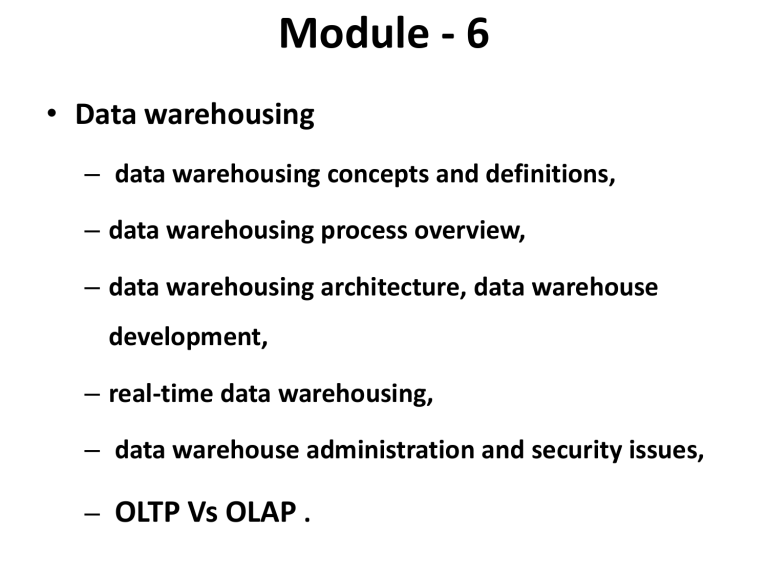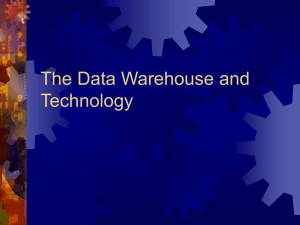
Module - 6 • Data warehousing – data warehousing concepts and definitions, – data warehousing process overview, – data warehousing architecture, data warehouse development, – real-time data warehousing, – data warehouse administration and security issues, – OLTP Vs OLAP . Data Warehousing concepts and definitions Data Warehousing • A Data warehouse is repository of information collected from multiple sources, stored under a unified schema, and that usually resides at a single site. • Data Warehouse: a centralized data repository which can be queried for business benefit. Client Data source in India Data source in New York Clean Integrate Transform Data Warehouse Query & Analysis Tools Load Refresh Data source in Japan Data source in China Client • A data warehouse is a subject-oriented, integrated, time-variant, and nonvolatile collection of data in support of management’s decision-making process.”— W. H. Inmon • Data warehousing: – The process of constructing and using data warehouses Characteristics of Data Warehousing 1. subject-oriented, 2. integrated, 3. time-variant, 4. nonvolatile Data Warehouse—Subject-Oriented • Organized around major subjects, such as customer, product, sales rather than day to day operations and transactions • Focusing on the modeling and analysis of data for decision makers, not on daily operations or transaction processing • Provide a simple and concise view around particular subject issues by excluding data that are not useful in the decision support process Data Warehouse—Integrated • Constructed by integrating multiple, heterogeneous data sources – relational databases, flat files, on-line transaction records • Data cleaning and data integration techniques are applied. – Ensure consistency in naming conventions, encoding structures, attribute measures, etc. among different data sources • E.g., Hotel price: currency, tax, breakfast covered, etc. – When data is moved to the warehouse, it is converted. Data Warehouse—Time Variant • The time horizon for the data warehouse is significantly longer than that of operational systems – Operational database: current value data – Data warehouse data: provide information from a historical perspective (e.g., past 5-10 years) • Every key structure in the data warehouse – Contains an element of time, explicitly or implicitly – But the key of operational data may or may not contain “time element” Data Warehouse—Nonvolatile • A physically separate store of data transformed from the operational environment • Operational update of data does not occur in the data warehouse environment – Does not require transaction processing, recovery, and concurrency control mechanisms – Requires only two operations in data accessing: • initial loading of data and access of data • Some additional characteristics may include the following: 1. Web based- Data warehouses are typically designed to provide an efficient computing environment for Web- based applications. 2. Relational/multidimensional- A data warehouse uses either a relational structure or a multidimensional structure. 3. Client/server- A data warehouse uses the client/ server architecture to provide easy access for end users. 4. Real time- Newer data warehouses provide real-time, or active, data-access and analysis capabilities 5. Include metadata- A data warehouse contains metadata (data about data) about how the data are organized and how to effectively use them. What can business analysts gain from having a data warehouse? • • • • Competitive advantage Productivity Customer relationship management Cost reduction Three types of Data Warehouses • Enterprise data warehouse (EDW) – collects all of the information about subjects spanning the entire organization • Data Marts – a subset of corporate-wide data that is of value to a specific groups of users. Its scope is confined to specific, selected groups, such as marketing data mart • Independent vs. dependent (directly from warehouse) data mart • Virtual warehouse (operational data stores-ODS) – A set of views over operational databases – Only some of the possible summary views may be materialized May 6, 2022 Data Mining: Concepts and Techniques 14 • An Enterprise Data warehouse collects information about subjects that span an entire organization and thus its scope is enterprise wide. • A Data Mart is a department subset of a data warehouse. It focuses on selected subjects, thus its scope is department wide • A data mart is a smaller, more focused data warehouse. It reflects the business rules of a specific business unit. The Data Mart is More Specialized The data mart serves the needs of one business unit, not the organization. Finance Data Mart Marketing Data Mart Accting Data Mart Organizational Data Warehouse © 2003, Prentice-Hall Sales Data Mart • A data mart can be either dependent or independent. • A dependent data mart is a subset that is created directly from the data warehouse. • It has the advantages of using a consistent data model and providing quality data. • A dependent data mart ensures that the end user is viewing the same version of the data that is accessed by all other data warehouse users. • Disadvantage: The high cost of data warehouses limits their use to large companies. • As an alternative, many firms use a lower-cost, scaled-down version of a data warehouse referred to as an independent data mart. • An independent data mart is a small warehouse designed for a department or strategic business unit (SBU), but its source is not an EDW. Metadata Repository • Metadata is data about data. • Metadata is the data defining warehouse objects. • Metadata describe the structure of and some meaning about data, thereby contributing to their effective or ineffective use. • Pattern is another way to view metadata. • According to the pattern view, we can differentiate between syntactic metadata (i.e., data describing the syntax of data), structural metadata (i.e., data describing the structure of the data), and semantic metadata (i.e., data describing the meaning of the data in a specific domain). • Metadata Repository should contain(it stores): – Description of the structure of the data warehouse • schema, view, dimensions, hierarchies, derived data defn, data mart locations and contents – Operational meta-data • data lineage (history of migrated data and transformation path), currency of data (active, archived, or purged), monitoring information (warehouse usage statistics, error reports, audit trails) – The algorithms used for summarization – The mapping from operational environment to the data warehouse – Data related to system performance • warehouse schema, view and derived data definitions – Business data • business terms and definitions, ownership of data, charging policies OLTP Vs OLAP • Most people are familiar with commercial relational database systems, it is easy to understand what a data warehouse is by comparing these two kinds of systems. • The major task of on-line operational database systems is to perform on-line transaction and query processing. • These systems are called on-line transaction processing (OLTP) systems. • They cover most of the day-to-day operations of an organization, such as purchasing, inventory, manufacturing, banking, payroll, registration, and accounting. • Data warehouse systems, on the other hand, serve users or knowledge workers in the role of data analysis and decision making. • Such systems can organize and present data in various formats in order to accommodate the diverse needs of the different users. • These systems are known as on-line analytical processing (OLAP) systems. Online Transaction Processing(OLTP) • Deals with operational data, which is data involved in the operation of a particular system. • The main emphasis for OLTP systems is put on very fast query processing and effectiveness is measured by number of transactions per second. • In an OLTP system, the data is frequently updated and queried. • To prevent data redundancy and to prevent update anomalies the database tables are normalized. • Eg: In a banking System, you withdraw amount through an ATM. Then account number, ATM PIN number, Amount you are with drawing and Balance amount in account are operational data elements. Online Analytical Processing(OLAP) • Deals with Historical Data and it is characterized by relatively low volume of transactions. • Queries needed for these systems are often very complex • The response time is an effectiveness measure • Example: If we collect last 10 years data about flight reservation, the data can give us much meaningful information such as the trends in reservation. This may give useful information like peak time of travel, and what kinds of people are travelling in the various classes available • Online Analytic Processing (OLAP): provides more complex queries than OLTP. • OLAP operations use background knowledge regarding the domain of the data being studied in order to allow the presentation of data at different levels of abstraction. • Such operations accommodate different user viewpoints. • OLAP Operations include: Roll-up- it involves summarizing the data along a dimension. [The summarization rule might be computing totals along a hierarchy or applying a set of formulas such as "profit = sales – expenses”] Drill-down/Up - allow the user to view the data at differing degrees of summarization. Drill Down/Up allows the user to navigate among levels of data ranging from the most summarized (up) to the most detailed (down) Slice and Dice – Slice is the act of picking a rectangular subset of a cube by choosing a single value for one of its dimensions, creating a new cube with one fewer dimension – Dice: The dice operation produces a sub-cube by allowing the analyst to pick specific values of multiple dimensions • Roll up (drill-up): summarize data – by climbing up hierarchy or by dimension reduction • Drill down (roll down): reverse of roll-up – from higher level summary to lower level summary or detailed data, or introducing new dimensions • Slice and dice: project and select • Pivot (rotate): – reorient the cube, visualization, 3D to series of 2D planes • Other operations – drill across: involving (across) more than one fact table – drill through: through the bottom level of the cube to its backend relational tables (using SQL) May 6, 2022 Data Mining: Concepts and Techniques 29 OLAP Operations Roll Up Drill Down Single Cell Multiple Cells Slice Data Mining: May use OLAP queries. Dice Comparison between OLTP & OLAP Systems • The major distinguishing features between OLTP and OLAP are summarized as follows: 1. Users and system orientation: An OLTP system is customer-oriented and is used for transaction and query processing by clerks, clients, and information technology professionals. An OLAP system is market-oriented and is used for data analysis by knowledge workers, including managers, executives, and analysts. 2. Data contents: An OLTP system manages current data that, typically, are too detailed to be easily used for decision making. An OLAP system manages large amounts of historical data, provides facilities for summarization and aggregation, and stores and manages information at different levels of granularity. These features make the data easier to use in informed decision making. 3. Database design: An OLTP system usually adopts an entityrelationship (ER) data model and an application-oriented database design. An OLAP system typically adopts either a star or snowflake model and a subject-oriented database design. 4. Access patterns: The access patterns of an OLTP system consist mainly of short, atomic transactions. Such a system requires concurrency control and recovery mechanisms. However, accesses to OLAP systems are mostly read-only operations (because most data warehouses store historical rather than up-todate information), although many could be complex queries. 5. View: An OLTP system focuses mainly on the current data within an enterprise or department, without referring to historical data or data in different organizations. In contrast, an OLAP system often spans multiple versions of a database schema, due to the evolutionary process of an organization. OLAP systems also deal with information that originates from different organizations, integrating information from many data stores. Because of their huge volume, OLAP data are stored on multiple storage media. Data Warehouse vs. Operational DBMS • OLTP (on-line transaction processing) – Major task of traditional relational DBMS – Day-to-day operations: purchasing, inventory, banking, manufacturing, payroll, registration, accounting, etc. • OLAP (on-line analytical processing) – Major task of data warehouse system – Data analysis and decision making • Distinct features (OLTP vs. OLAP): – – – – – User and system orientation: customer vs. market Data contents: current, detailed vs. historical, consolidated Database design: ER + application vs. star + subject View: current, local vs. evolutionary, integrated Access patterns: update vs. read-only but complex queries OLTP vs. OLAP OLTP OLAP characteristic clerk, IT professional (customer oriented) Operational processing knowledge worker (market oriented) Informational processing orientation transaction analysis function day to day operations DB design application-oriented (ER model) current, up-to-date detailed, flat relational isolated repetitive Long term information requirements, decision support subject-oriented (star or snowflake model) historical, summarized, multidimensional,integrated, consolidated ad-hoc (i.e for a specific task / purpose / problem) Mostly read users data usage operations read/write (atomic transactions) index/hash on prim. Key focus Data in Information out unit of work short, simple transaction complex query # records accessed tens millions access lots of scans Representation of Data in Data Warehouse • Modeling data warehouses: dimensions & measures – Star schema: A fact table in the middle connected to a set of dimension tables – Snowflake schema: A refinement of star schema where some dimensional hierarchy is normalized into a set of smaller dimension tables, forming a shape similar to snowflake – Fact constellations: Multiple fact tables share dimension tables, viewed as a collection of stars, therefore called galaxy schema or fact constellation Example of Star Schema time item time_key day day_of_the_week month quarter year Sales Fact Table time_key item_key branch_key branch branch_key branch_name branch_type location_key units_sold dollars_sold avg_sales Measures item_key item_name brand type supplier_type location location_key street city state_or_province country Example of Snowflake Schema time time_key day day_of_the_week month quarter year item Sales Fact Table time_key item_key branch_key branch location_key branch_key branch_name branch_type units_sold dollars_sold avg_sales Measures item_key item_name brand type supplier_key supplier supplier_key supplier_type location location_key street city_key city city_key city state_or_provinc e country Example of Fact Constellation time time_key day day_of_the_week month quarter year item Sales Fact Table time_key item_key item_name brand type supplier_type item_key location_key branch_key branch_name branch_type units_sold dollars_sold avg_sales Measures time_key item_key shipper_key from_location branch_key branch Shipping Fact Table location to_location location_key street city province_or_state country dollars_cost units_shipped shipper shipper_key shipper_name location_key shipper_type From Tables and Spreadsheets to Data Cubes • A data warehouse is based on a multidimensional data model which views data in the form of a data cube • A data cube, such as sales, allows data to be modeled and viewed in multiple dimensions – Dimension tables, such as item (item_name, brand, type), or time(day, week, month, quarter, year) describes the dimension. – Fact table contains the names of the facts or measures (such as dollars_sold) and keys to each of the related dimension tables (facts are numerical measures) Cube: A Lattice of Cuboids all time item time,location time,item 0-D(apex) cuboid location supplier item,location time,supplier 1-D cuboids location,supplier 2-D cuboids item,supplier time,location,supplier 3-D cuboids time,item,location time,item,supplier item,location,supplier 4-D(base) cuboid time, item, location, supplier


